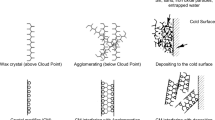Abstract
An experiment was conducted to characterize the effects of SOF on EGR cooler fouling. A removable singletube test rig combined with a soot generator was developed to represent an EGR cooler and diesel exhaust gas. The use of a soot generator, which controlled the size and concentration of soot particles, enabled independent variables to be completely controlled. Either n-dodecane or diesel lube oil as substitute SOFs were vaporized and injected into the test rig to evaluate their effects on the growth of PM deposits and the degradation performance of the EGR cooler. Coolant temperature, which seemed to be associated with SOF content, was chosen as an independent variable, and PM deposit mass per unit area and the effectiveness drop versus time increased as the coolant temperature decreased. The PM deposit mass per unit area and effectiveness drop had maximum values at a coolant temperature of 40°C for every n-dodecane injection rate. For substitute SOFs tested in this experiment, the deposit mass increased when either n-dodecane or diesel lube oil was injected, but the effect of lube oil was more significant. Diesel lube oil seemed to have a stronger effect on the reduction of thermal conductivity by filling pores in the deposits. When diesel lube oil was injected, the deposit mass per unit area increased 127% compared to dry soot without injection. The effectiveness drop after 10 hours increased only 12.5%.
Similar content being viewed by others
References
Abd-Alla, G. H. (2002). Using exhaust gas recirculation in internal combustion engines: A Review. Energy Conversion & Management, 43, 1027–1042.
Cartellieri, W. and Tritthart, P. (1984). Particulate analysis of light-duty diesel engines (IDI & DI) with particular reference to the lube oil fraction. SAE Paper No. 840418.
Charles, F. L. R., Ewing, D., Becard, J., Chang, J. S. and Cotton, J. S. (2005). Optimization of the exhaust mass flow rate and coolant temperature for exhaust gas recirculation (EGR) cooling devices used in diesel engines. SAE Paper No. 2005-01-0654.
Grillot, J. M. and Icart, G. (1997). Fouling of a cylindrical probe and a finned tube bundle in a diesel exhaust environment. Experimental Thermal and Fluid Science, 14, 442–454.
Hoard, J., Abarham, M., Styles, D., Giuliano, J. M., Sluder, C. S. and Storey, J. M. E. (2008). Diesel EGR cooler fouling. SAE Paper No. 2008-01-2475.
Ismail, B., Charles, F., Ewing, D., Cotton, J. S. and Chang, J. S. (2005). Mitigation of the diesel soot deposition effect on the exhaust gas recirculation (EGR) cooling devices for diesel engines. SAE Paper No. 2005-01-0656.
Ladommatos, N., Abdelhalim, S. M. and Zhao, H. (1998). Effects of exhaust gas recirculation temperature on diesel engine combustion and emissions. Prog. Energy Combust. Sci., 212, 479–500.
Ladommatos, N., Abdelhalim, S. M., Zhao, H. and Hu, Z. (1998). The effects of carbon dioxide in exhaust gas recirculation on diesel engine emissions. Prog. Energy Combust. Sci., 212, 25–42.
Lance, M. J., Sluder, C. S., Wang, H., Storey J. M. E. and (2009). Direct measurement of EGR cooler deposit thermal properties for improved understanding of cooler fouling. SAE Paper No. 2009-01-1461.
Maing, S., Lee, K. S., Song, S., Chun, K. M. and Oh, B. (2007). Simulation of the EGR cooler fouling effect on NOx emission of a light duty diesel engine. 2007 Fall Conf. Proc., 1, KSAE07-F0035, 214–220.
Sahetchian, K., Champoussin, J. C., Brun, M., Levy, N., Blin-Simiand, N., Aligrit, C., Jorand, F., Socoliuc, M. and Heiss, A. (1995). Experimental study and modeling of dodecane ignition in a diesel engine. Combustion and Flame, 103, 207–220.
Teng, H. and Barnard, M. (2010). Physicochemical characteristics of soot deposits in EGR coolers. SAE Paper No. 2009-01-2877.
Usui, S., Ito, K. and Kato, K. (2004). The effect of semicircular micro riblets on the deposition of diesel exhaust particulate. SAE Paper No. 2004-01-0969.
William, C. H. (1999). Aerosol Technology. 2nd Edn. John Wiley & Sons. New York. 171–172.
Zhan, R., Eakle, S. T., Miller, J. W. and Anthony, J. W. (2008). EGR system fouling control. SAE Paper No. 2008-01-0066.
Zhang, F. and Nieuwstadt, M. (2008). Adaptive EGR cooler pressure drop estimation. SAE Paper No. 2008-01-0624.
Zheng, M., Reader, G. T. and Hawley, J. G. (2004). Diesel engine exhaust gas recirculation — A review on advanced and novel concepts. Energy Conversion & Management, 1145, 883–900.
Author information
Authors and Affiliations
Corresponding author
Rights and permissions
About this article
Cite this article
Hong, K.S., Park, J.S. & Lee, K.S. Experimental evaluation of SOF effects on EGR cooler fouling under various flow conditions. Int.J Automot. Technol. 12, 813–820 (2011). https://doi.org/10.1007/s12239-011-0093-x
Received:
Revised:
Published:
Issue Date:
DOI: https://doi.org/10.1007/s12239-011-0093-x




